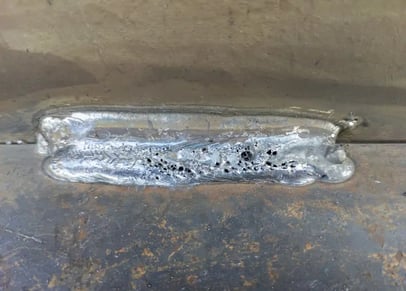What is Porosity in Welding: Best Practices for Preventing Permeable Welds
What is Porosity in Welding: Best Practices for Preventing Permeable Welds
Blog Article
Deciphering the Mystery of Porosity in Welding: Tips for Reducing Defects and Taking Full Advantage Of Quality
In the elaborate world of welding, porosity stays a relentless difficulty that can substantially affect the high quality and honesty of bonded joints. Recognizing the variables that add to porosity development is critical in the quest of perfect welds. By unwinding the secret of porosity and implementing efficient techniques for defect minimization, welders can raise the standards of their work to attain premium high quality outcomes. As we look into the midsts of porosity in welding, uncovering the secrets to its avoidance and control will certainly be extremely important for specialists looking for to master the art of premium weldments.
Comprehending Porosity in Welding
Porosity in welding, an usual issue experienced by welders, describes the visibility of gas pockets or voids in the bonded product, which can jeopardize the honesty and high quality of the weld. These gas pockets are usually entraped throughout the welding procedure due to numerous aspects such as inappropriate protecting gas, polluted base materials, or wrong welding parameters. The formation of porosity can weaken the weld, making it prone to cracking and corrosion, ultimately causing structural failings.
Understanding the source of porosity is important for welders to efficiently stop its incident. By acknowledging the significance of maintaining correct gas securing, ensuring the tidiness of base products, and enhancing welding settings, welders can substantially minimize the chance of porosity formation. Furthermore, using methods like preheating the base product, utilizing correct welding techniques, and conducting extensive inspections post-welding can better assist in lessening porosity problems. On the whole, an extensive understanding of porosity in welding is essential for welders to generate high-grade and sturdy welds.

Common Reasons of Porosity
When checking welding procedures for possible high quality concerns, recognizing the typical reasons for porosity is vital for preserving weld integrity and protecting against structural failings. Porosity, characterized by the existence of cavities or gaps in the weld metal, can considerably endanger the mechanical properties of a bonded joint. One usual reason of porosity is incorrect protecting gas insurance coverage. Inadequate shielding gas circulation rates or incorrect gas combinations can lead to climatic contamination, leading to porosity formation.
In addition, welding at inappropriate criteria, such as exceedingly high travel rates or currents, can create extreme disturbance in the weld pool, trapping gases and causing porosity. By attending to these common reasons via correct gas securing, material preparation, and adherence to optimal welding criteria, welders can lessen porosity and enhance the high quality of their welds.
Techniques for Porosity Avoidance
Executing reliable safety nets is essential in minimizing the event of porosity in welding procedures. One method for porosity prevention is ensuring proper cleansing of the base metal before welding. Contaminants such as oil, oil, corrosion, and paint can cause porosity, so detailed cleansing using ideal solvents or mechanical techniques is crucial.

Making use of high-quality filler products and securing gases that are appropriate for the base steel and welding procedure can significantly lower the danger of porosity. Additionally, maintaining proper welding specifications, such as voltage, present, take a trip rate, and gas circulation price, is important for porosity avoidance.
Furthermore, utilizing appropriate welding strategies, such as maintaining a constant travel rate, electrode angle, and arc length, can assist stop porosity (What is Porosity). Ample training of welders to guarantee they comply with finest practices and quality assurance treatments is additionally important in decreasing porosity problems in welding

Ideal Practices for Quality Welds
Ensuring adherence to sector requirements and appropriate weld joint prep work are essential elements of attaining continually top notch welds. In enhancement to these foundational actions, there are several ideal techniques that welders can carry out to additionally improve the quality of their welds. One trick technique is maintaining correct sanitation in the welding location. Pollutants such as oil, oil, rust, and paint can adversely impact the top quality of the weld, resulting in issues. Completely cleaning up the workpiece and surrounding location prior to welding can aid alleviate these problems.
Another finest technique is to carefully select the suitable welding parameters for the particular materials being signed up with. Appropriate specification choice guarantees optimum weld penetration, blend, and overall quality. Using premium welding consumables, such as electrodes and filler steels, can dramatically impact the final weld high quality.
Relevance of Porosity Control
Porosity control plays an essential function in making certain the honesty and quality of welding joints. Porosity, defined by the existence of dental caries or voids within the weld metal, can substantially his response endanger the his response mechanical residential properties and structural integrity of the weld. Extreme porosity deteriorates the weld, making it much more at risk to breaking, rust, and overall failing under operational lots.
Effective porosity control is important for maintaining the wanted mechanical residential properties, such as stamina, ductility, and durability, of the bonded joint. What is Porosity. By lessening porosity, welders can improve the total quality and dependability of the weld, ensuring that it meets the efficiency demands of the designated application
Moreover, porosity control is essential for achieving the wanted visual appearance of the weld. Too much porosity not just weakens the weld however also detracts from its aesthetic allure, which can be essential in sectors where looks are very important. Correct porosity control techniques, such as using the proper shielding gas, managing the welding specifications, and making sure appropriate tidiness of the base materials, are important for producing premium welds with very little issues.

Conclusion
In final check out this site thought, porosity in welding is a common problem that can jeopardize the top quality of the weld. It is necessary to manage porosity in welding to make certain the integrity and toughness of the last product.
Report this page